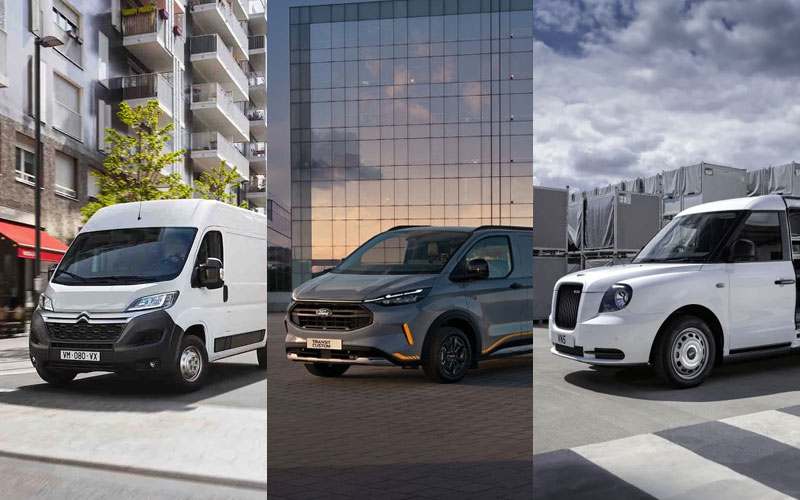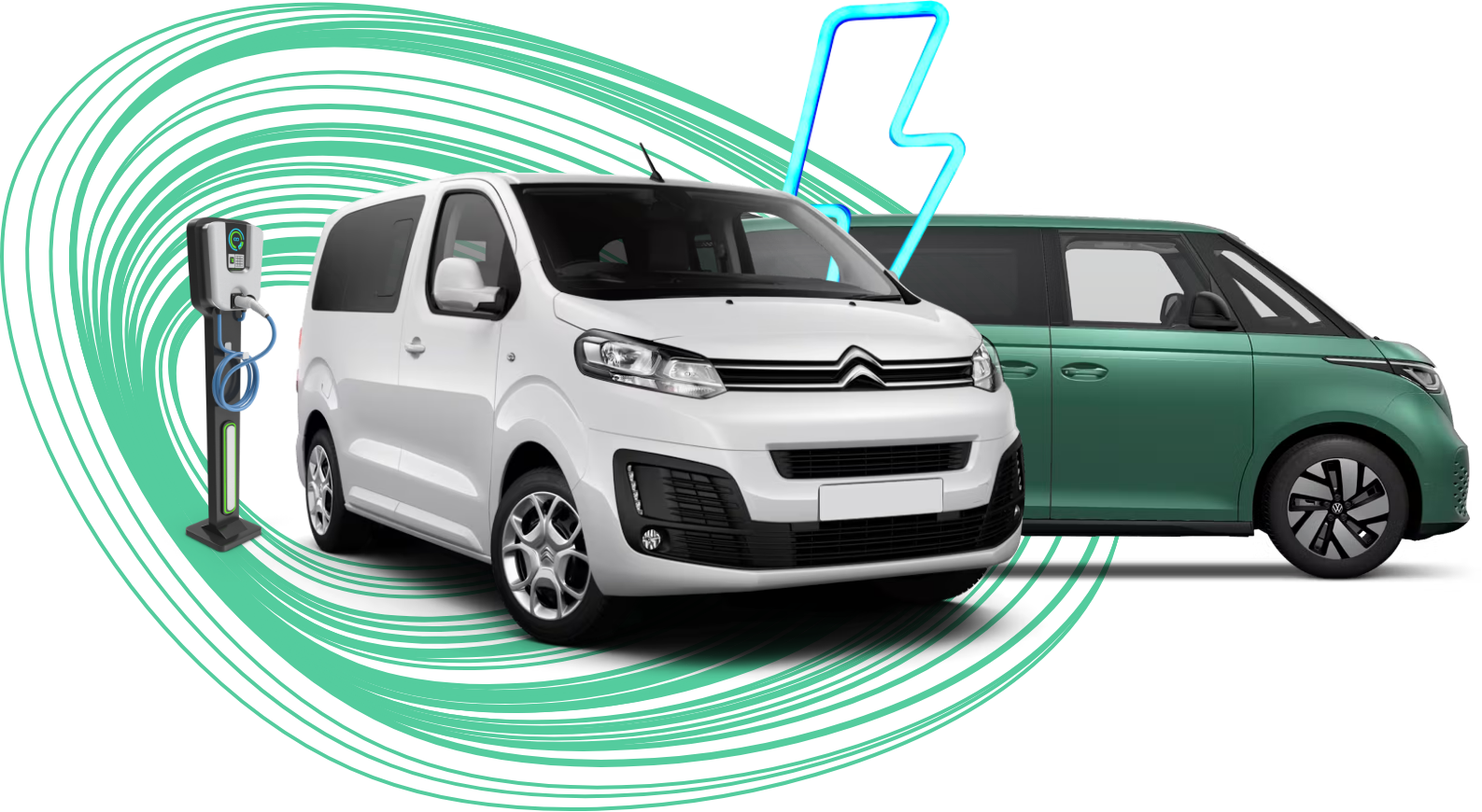The Different Types of Electric Vans Explained

In this article, we’ll take you through the different types of electric vans, breaking down all those acronyms so you know what’s what.
- There are three main types of electric vans available to buy. Battery Electric Vans (BEVs), Hybrid Electric Vans (HEVs) and Plug-in Hybrid Electric Vans (PHEVs). There are also some Extended Range Electric Vans (EREVs).
- Each of these will work slightly differently and offer different benefits when it comes to driving experience, costs, and more.
- Knowing the difference between these electric vans will make it easier to decide which type is right for you and your business.
When talking about electric vehicles, we often refer to them collectively as one group. However, as with electric cars, there are also different types of electric vans.
If you’re considering leasing an electric van, then it may be useful to know the difference between these. This way, you can ensure you choose the right one for your needs. Read on to learn all about the different types of electric vans available.
What is a Battery Electric Van (BEV)?
As their name suggests, battery-electric vans are 100% electric, powered solely by a battery instead of an engine.
Since the battery is the only power source, BEVs need to be plugged in to recharge once the battery level is depleted.
The battery will typically be larger than those found in plug-in hybrid electric vans (PHEVs). This sends power to an electric motor which drives the wheels of the van.
Features and benefits of a battery electric van (BEV)
Battery electric vans are relatively simple when it comes to parts. These are the battery, electric motor, inverter, controller, and thermal cooling system.
If you’re looking to make a change to your business with a fully electric van, you’ll enjoy several benefits. These include:
- More eco-friendly – fully electric vans produce zero emissions making them a friend to the environment.
- Business savings – you’ll pay zero road tax and no congestion zone charges with a battery-electric van.
- Improved business image – with more focus on the environment, customers are looking to make better choices.
- Smoother driving experience – fully electric vans are automatic. The electric motor also enables instant torque and acceleration for a more responsive drive.
Another key benefit of electric vans is that many of these are eligible for the government’s Plug-in Van Grant (PiVG). This gives you financial support to help cover the initial costs of your electric van, with savings of up to £2,500 for small vans and £5,000 for large vans.
You can also access funding to help cover the costs of purchasing and installing a home charge point for your electric van.
Range and performance of a battery electric van (BEV)
When it comes to range, this varies depending on the battery electric van you choose. Most electric vans offer a range of between 100-200 miles or more on a single charge.
This is because they are often made with different-sized batteries. If your electric van has a smaller battery, you’ll normally have less driving range, however you’ll typically enjoy a higher payload.
On the flip side, if you have a large battery you’ll enjoy more driving range, though you might have to compromise on your cargo capacity.
Other things that can affect the driving range of your electric van include:
- Weather conditions
- Driving style
- Using the air-con system
- The condition of your tyres
As for performance, you’ll notice a much quieter, smoother drive with a battery-electric van. With no engine rumbling under the bonnet, electric vans are near-silent with only the subtle sound of the motor.
They’re also much smoother to drive thanks to automatic transmission, without the hassle of changing gears. Especially handy for when you’re caught in slow-moving traffic!
Pros and cons of a battery electric van (BEV)
Pros
- Zero road tax to pay
- Cleaner to the environment
- Zero costs for entering Low Emission Zones (LEZs)
- Financial incentives available to help with purchase
Cons
- Will require regular recharging
- Higher initial price point than non-electric vans
- Larger battery = lower payload
- Public charging access lacking in places
What is a Hybrid Electric Van (HEV)?
Hybrid Electric Vans (HEVs) are powered by a combination of sources, hence the ‘hybrid’ part. They normally feature a small petrol or diesel engine, alongside an electric motor.
The electric motor is used for shorter commutes to help improve efficiency, while the engine will kick in for longer journeys.
As with many other hybrid vehicles, hybrid vans won’t need plugging in to recharge since they do so on the go. Through regenerative braking, any energy lost when slowing down is collected and used to help charge the battery.
This makes them different to plug-in hybrid vans, which we’ll come onto later.
Features and benefits of a hybrid electric van (HEV)
A hybrid van offers the perfect solution for businesses who are unsure about going fully electric.
They offer all the benefits of an electric van, without the burden of regular charging. Including:
- Lower emissions helping save money on both road tax and congestion zone charges
- A driving experience suited to you, with the choice of manual or automatic transmission
- Reduced fuel consumption when driving in electric mode
- More economical, lightweight design compared to petrol or diesel vans More flexible range and mileage
If you’re looking to improve your eco credentials while still maintaining a normal driving experience, a hybrid van will be ideal.
Range and performance of a hybrid electric van (HEV)
As with electric vans, range will also vary with hybrid vans depending on the make and model.
Since they aren’t fully electric, electric driving range will be notably lower with HEVs compared to BEVs. On average, hybrid electric vans tend to offer an electric driving range of between 26-61 miles, which is all you need for working locally.
As for performance, hybrid electric vans are relatively easy to drive. HEVs with automatic transmission will offer a smoother, quieter drive compared to petrol or diesel vans. Alternatively, if you’d prefer a more engaging drive, manual HEVs will make a good choice.
Pros and cons of a hybrid electric van (HEV)
Pros
- Lower tailpipe emissions meaning lower road tax
- Exemption from congestion zone charges in all-electric mode
- Improved fuel economy with reduced consumption
- Choice of manual or automatic transmission
Cons
- Limited all-electric range compared to BEVs
- Not as efficient to drive as a fully electric van
- Fewer choice of models currently available
- Not eligible for government grants to help with purchase
What is a plug-in hybrid electric van (PHEV)?
With plug-in hybrid electric vans (PHEVs) it’s all in the name. These electric vans feature either a petrol or diesel engine with an electric motor, referring to the ‘hybrid’ part.
They also need to be plugged in to recharge once the battery level decreases, similar to battery electric vehicles (BEVs).
Features and benefits of plug-in hybrid electric vans (PHEVs)
As with battery electric vans, there are several benefits to driving a plug-in hybrid electric van (PHEV), including:
- Fewer emissions – meaning cheaper road tax
- Improved sustainability image for your business
- Lower running costs with fuel savings
- Improved fuel economy
PHEVs are, of course, also eligible for the PiVG grant, helping you cut the initial costs when it comes to buying or leasing one.
Since PHEVs are not fully reliant on electric power, they will normally offer a choice of driving modes. It’s when driving in electric mode that you’ll be able to reap the rewards mentioned above.
For instance, when driving into cities operating Low Emission Zones (LEZs), you won’t have to pay any charges if you’re in full electric mode.
Driving in electric mode will also help you to save on fuel, using less petrol or diesel from the tank. You could prioritise electric driving for shorter trips and save your miles for longer journeys on the motorway. It’s all up to you!
Offering more flexibility when it comes to driving style, plug-in hybrid vans are great if you don’t fancy making the full switch to electric.
Range and performance of a plug-in hybrid electric van (PHEV)
Similarly to BEVs, PHEVs will offer different driving ranges depending on the size of the battery. As a general guide, they tend to offer between 20-50 miles of fully electric driving range.
With a PHEV, the engine and electric motor will work in parallel alongside each other. The electric range is typically used at lower speeds for shorter distances. The internal combustion engine (ICE) will kick in once the range depletes, so you don’t have to worry about losing power.
Using different driving modes, you’ll be able to optimise fuel economy or conserve energy based on your needs.
PHEVs are also automatic, so you’ll still enjoy the same smooth drive as you would with an electric van.
Pros and cons of a plug-in hybrid electric van (PHEV)
Pros
- More flexible driving experience
- Fuel and tax savings
- Easy to recharge
- Lower emissions
Cons
- Less driving range than with a BEV
- Will require regular recharging
- Not as efficient as fully electric vans
- Less powerful than BEVs – smaller battery
What is an extended-range electric van (EREV)?
Extended-range electric vans (EREVs) are a more recent innovation. Similar to PHEVs in that they combine both petrol or diesel and electric power. They are often referred to as ‘range extenders’.
However, unlike a PHEV, the engine is never responsible for driving the wheels directly. With an EREV, this remains the electric motor’s responsibility.
The market for EREVs remains small in the UK currently, with few of these available to buy. In time though, it’s possible we could see them develop as technology advances.
Features and benefits of extended-range electric vans (EREV)
Range-extended vehicles are a great way to experience the benefits of an EV, without going fully electric.
They offer similar benefits, such as:
- Reduced tailpipe emissions
- Lower road tax
- A more sustainable business reputation
- Potential fuel savings
With an EREV, you also won’t need to worry about range anxiety, since the range extender will kick in once the battery level becomes low.
Range and performance of an extended-range electric van (EREV)
According to Green Car Guide, EREVs typically offer an electric driving range with zero emissions of between 50-100 miles.
When driving in electric mode, you’ll get a taste for electric motoring with smoother, quieter performance. As a type of electric vehicle, EREVs are also automatic offering a more relaxing drive.
As with the other electric van types, EREVs will require plugging into a power source to recharge. The range extender simply acts as a secondary source of power to help extend your driving range.
Pros and Cons of an extended-range electric van (EREV)
Pros
- More eco-friendly than ICE vans
- No need to worry about range
- Fuel and road tax savings
- Smoother drive
Cons
- Limited choice available with currently only the LEVC VN5
- Range extender only acts as temporary source of power
- Less efficient than fully electric vans
- Technology needs further developing
Shop electric vans at Vansdirect
Decided to make the switch? At Vansdirect we have a wide range of new electric vans for lease. Shop the latest models from a range of manufacturers like Citroen, Peugeot, Ford, Renault, Nissan, and more.
With our competitive van leasing deals, you’re sure to get the best possible price for your new van. We also stock a range of fantastic vans on clearance if you want to enjoy even more savings.
Did we mention, we offer flexible finance packages tailored to your budget? Choose from Contract Hire, Hire Purchase or Van Fleet Leasing and split the costs into manageable monthly instalments.
Shop our latest electric vans on offer now or get in touch with our specialist team if you have any questions.
Find this electric van article interesting?
Check out our Electric Van Hub where you'll find even more useful information such as the benefits of electric vans and electric van reviews.
















